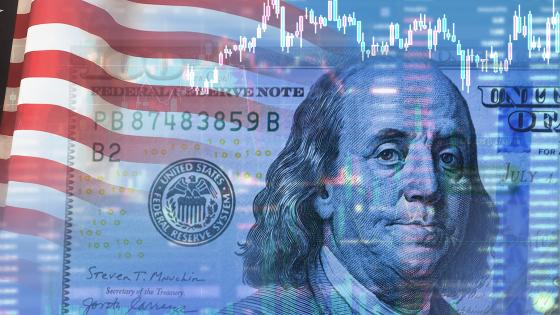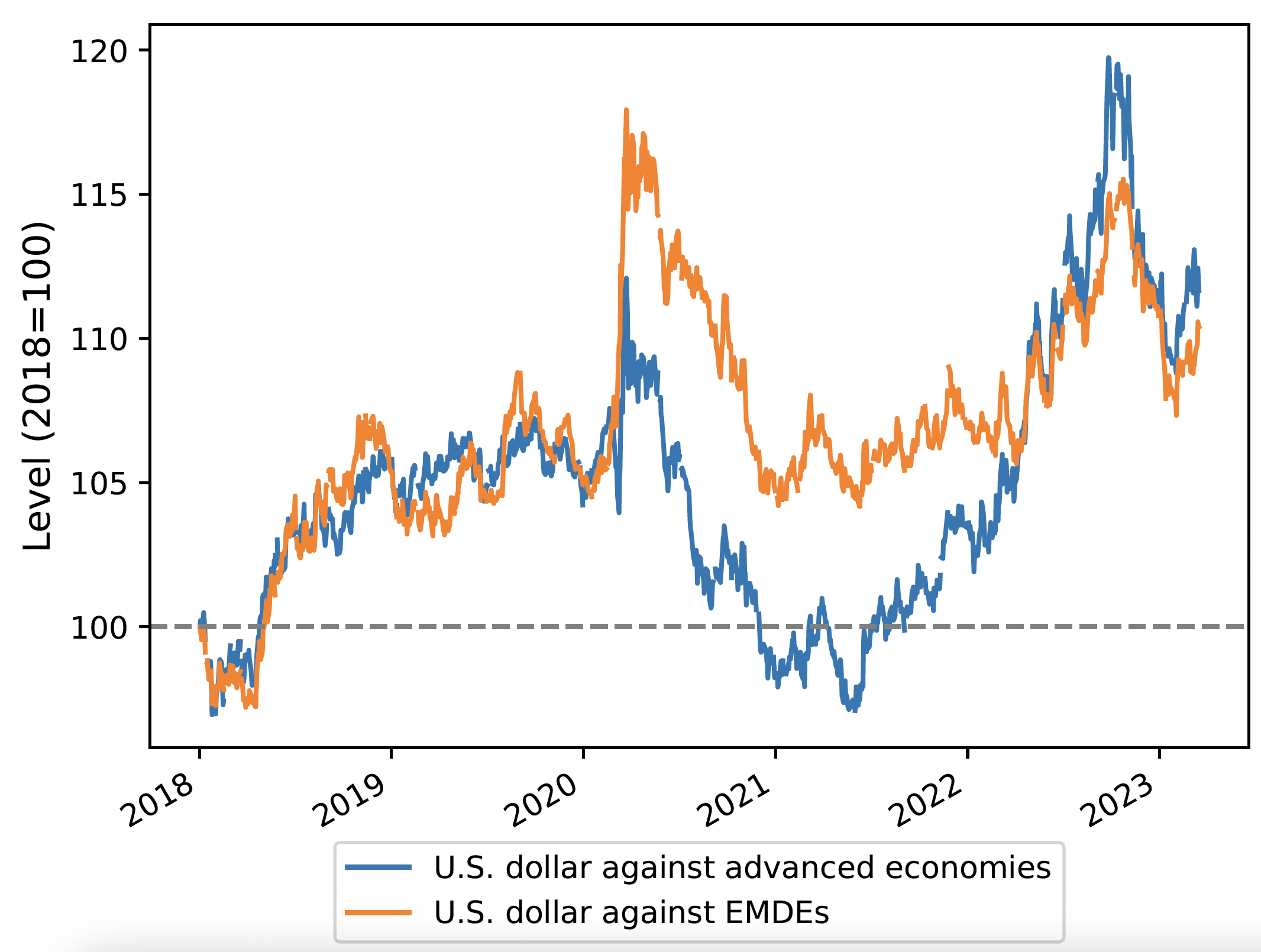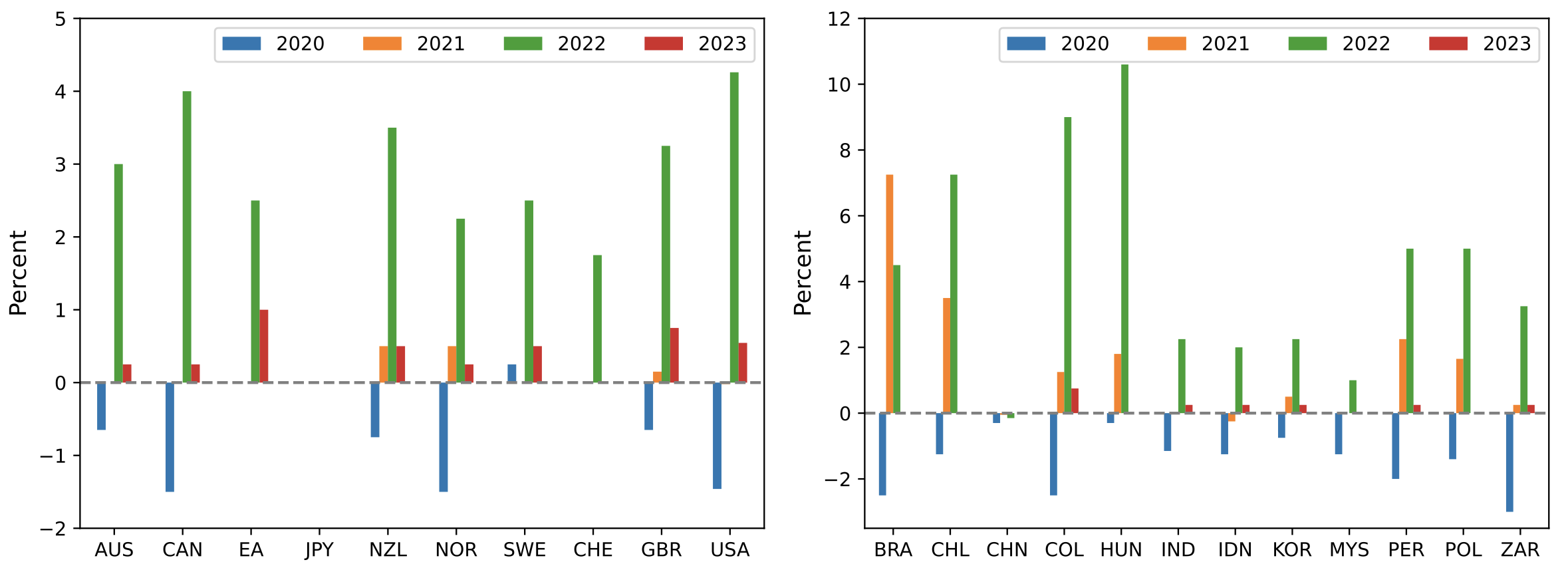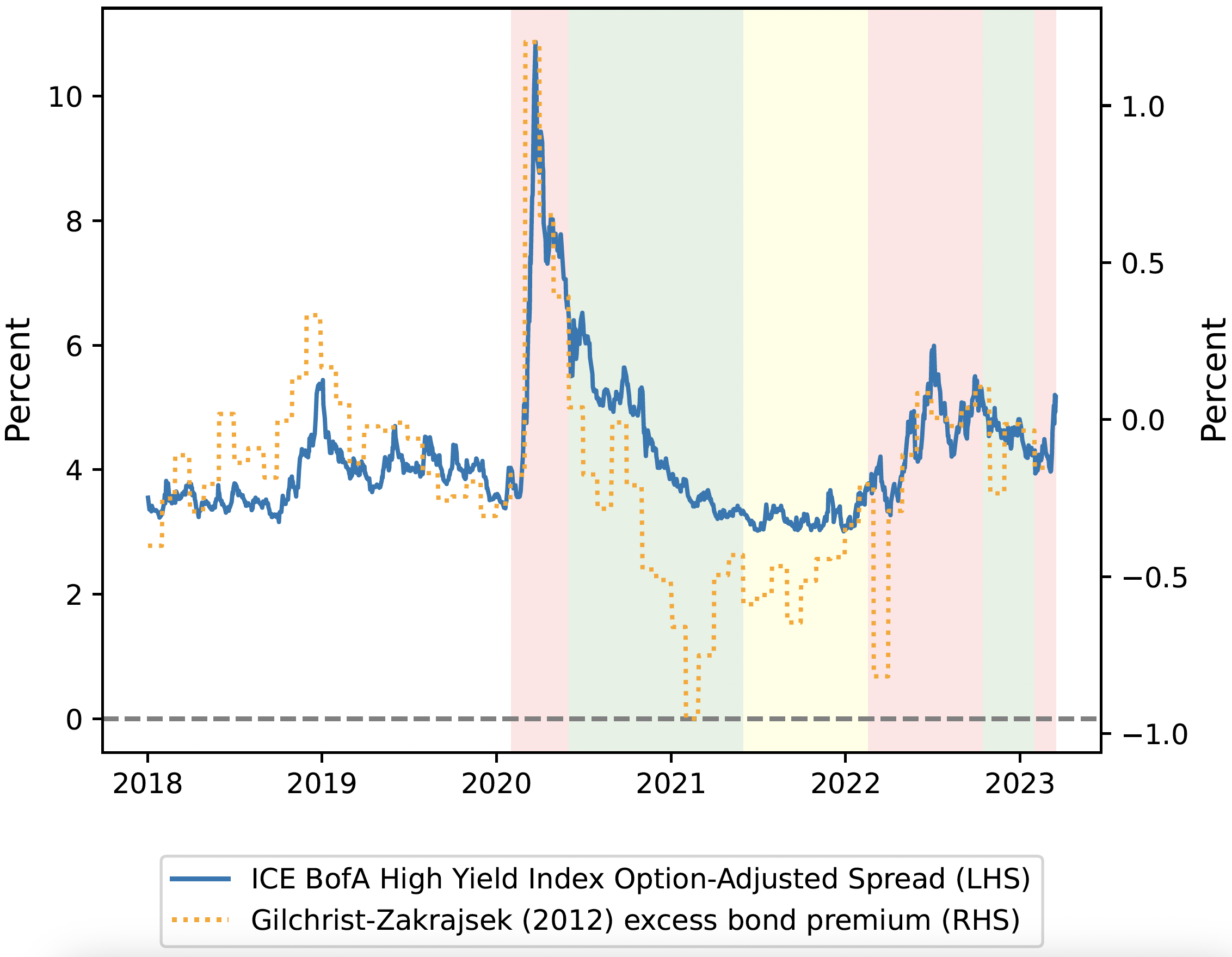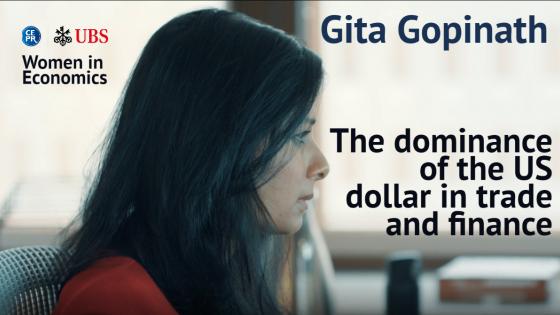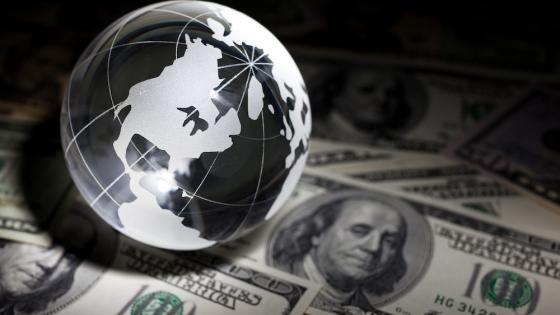Recent research on the international economy highlights medium-term global cycles of financial exuberance and gloom, characterised by boom and bust in asset prices, cross-border capital flows, risk taking, arbitrage, and leverage (Rey 2013, Shin and Bruno 2013, Miranda-Agrippino and Rey 2022). These bipolar market mood swings are highly correlated with movements in the nominal exchange rate of the US dollar: generally, upswings in dollar value accompany tighter financial conditions around the world, whereas dollar depreciation is associated with global financial easing.
The dollar experienced a pronounced cycle of depreciation succeeded by appreciation following the financial panic of March 2020 and extending through the third quarter of 2022. These dollar swings broadly tracked shifting global financial conditions. With the recent failure of Silicon Valley Bank (SVB) and renewed financial turbulence, it has become unclear what direction the dollar will now take. The answer will be consequential for the world economy.
Channels of dollar influence
The drivers of the relationship between global financial conditions and the dollar are surely bidirectional and mutually reinforcing, as global market turbulence leads to safe haven financial flows into US assets while dollar appreciation itself tends to tighten balance sheet constraints and depress demand worldwide. However, the dollar’s continuing outsized impact, notably on emerging market and developing economies (EMDEs) that have grown from 24.5% of the global economy in 1980 to 43.6% in 2022, is remarkable.
When the Bretton Woods system of fixed US dollar exchange rates collapsed 50 years ago this month, many predicted the end of the dollar’s postwar reign over the international monetary system. That prophecy has not (yet) come to pass (Goldberg and Lerman 2019, Gopinath 2020, Gourinchas 2021).
Empirically, the impacts of dollar movements seem to spill strongly into the real economies of EMDEs. A strong dollar depresses commodity exporters’ real terms of trade and are associated with lower global growth of output and of international trade volumes (e.g. Magud et al. 2015, Shin and Bruno 2021). Thus, it is no exaggeration to speak of a global dollar cycle that is strongly associated with oscillations in international financial and real activity. Of course, this mechanism makes US financial conditions and the Federal Reserve central to an understanding of global macro-financial developments (Kalemli-Özcan 2020). Currently, renewed dollar strength is again raising sustainability concerns about the debt levels in some EMDEs (e.g. Powell and Valencia 2023).
In a recent paper (Obstfeld and Zhou 2023), we investigate the impact of the global dollar cycle on EMDEs, as well as some main monetary and financial market correlates of dollar movements. To minimise feedback from EMDE developments to the dollar itself, our measure of dollar shocks is the change in the dollar’s effective nominal exchange rate against other advanced-country currencies. Using a local projections framework applied to a sample of 26 EMDEs spanning multiple regions, we find that dollar appreciation shocks predict a range of contractionary developments, including lower output growth, consumption, and investment; falls in tradable goods prices and the terms of trade; lower equity prices and credit growth; and wider spreads on sovereign foreign-currency borrowing. Figure 1 illustrates some of these effects, which we find to be more severe for countries that peg their currencies in the foreign exchange market, have greater dollar-denominated external debts, or do not practice inflation targeting. The results are in line with models in which a stronger dollar and the monetary policies that drive it have negative effects on economic actors’ balance sheets and borrowing capacity (for recent analyses, see Müller et al. 2021, Camara and Sangiácomo 2022, Abbassi and Bräuning 2023).
Figure 1 Impulse responses to a 10% increase in the USD exchange rate index against advanced-economy currencies
Source: Obstfeld and Zhou (2023)
In turn, the dollar’s exchange rate against advanced economies is correlated with a number of policy and financial factors. Prominent among these are short- and long-term interest differentials between US Treasury securities and foreign government bonds, demonstrating the importance of conventional and unconventional monetary policy channels. Also important, however, are indicators of liquidity differences between government bonds and of financial frictions or stresses. Among these, we find important roles for covered interest differentials (Sushko et al. 2016, Cerutti et al. 2020) and for the Gilchrist-Zakrajšek ‘excess bond premium’, or EBP (Zakrajšek et al. 2022). Notably, we find that our regressors yield very high R2s in equations for exchange-rate changes, echoing related results by Schreger et al. (2000).
The pandemic, global inflation, and the dollar
A renewed and turbulent phase of the dollar cycle started when COVID-19 broke out early in 2020 and economies around the world shut down. As Figure 2 shows, the dollar appreciated sharply in late March 2020 (just about exactly three years ago) as panic gripped global financial markets and liquidity evaporated. Initially, the dollar rose much more against the currencies of EMDEs, which seemed especially ill-equipped to contain the economic fallout of a global pandemic. Large-scale monetary and fiscal stimulus around the world restored a measure of calm in international markets, but the Fed’s massive suite of easing measures, including renewed dollar swap lines and facilities to stabilize the market for US Treasury liabilities, was especially powerful in view of the dollar’s global pre-eminence. On average, EMDE currencies returned to their pre-pandemic levels, whereas advanced currencies appreciated far beyond those levels, rising far more by the middle of 2021 than they had risen in the panic of March 2020.
Figure 2 US dollar exchange rate value against advanced and EMDE currencies
Source: Federal Reserve series H.10 release (FRED ticker DTWEXAFEGS; DTWEXEMEGS). Rebased to 2 January 2018 = 100
As vaccines became available early in 2021 and economies began to reopen, commodity prices rose and inflation pressures emerged worldwide, but with special force in the US. There, additional politically driven fiscal stimulus in late 2020 and after the presidential election in early 2021 had left households flush with cash even as supply chains remained clogged. Moreover, by June 2021 the dollar’s effective nominal exchange rate was at low levels last seen three years earlier when the Fed, led by newly appointed chair Jerome Powell, was in the midst of a monetary tightening cycle with several further hikes still to come. Unlike in most other economies, US output returned to its pre-COVID trend quickly. Markets began to anticipate that the Fed would start to raise interest rates before other economies and accordingly, the dollar began the renewed ascent evident in Figure 2. In March 2022 the Fed belatedly began its tightening cycle with a 25 basis point rise in the funds rate, just after Russia invaded Ukraine. Finding itself badly behind the curve, the Fed sharply accelerated the pace of tightening in subsequent policy meetings. The dollar soared and reached a peak in September-October 2022. Dollar appreciation took place despite rapid and progressive tightening by central banks around the world (though nowhere more aggressive than in the US). Figure 3 shows the global tightening cycle, which began even earlier in EMDEs (mid-2021) than in advanced economies.
Figure 3 Year-over-year changes in policy interest rate, advanced economies and EMDEs
Source: BIS, CEIC.Latest observation: March 23, 2023
What ended the upward phase of the dollar cycle in October 2022 was financial markets’ premature acceptance of a narrative that US inflation would abate more quickly than expected, resulting in a ‘soft landing’ for the US economy as well as early Fed interest rate cuts. That narrative was rudely corrected on 3 February 2023 when the US Bureau of Labor Statistics announced the creation of more than a half million jobs the month before – raising expected future US interest rates and setting off a renewed upward move in the dollar (Figure 2). The failure of Silicon Valley Bank earlier this month, the US rescue efforts for it and other mid-size banks, and the renewed turbulence in global financial markets – layered onto the ongoing inflation challenge to central banks – leaves the future direction of the dollar in doubt.
Recent phases of the dollar cycle are visible in the pattern of capital inflows to EMDEs, shown in Figure 4.
On average, these flows plummeted in the troubled first quarter of 2020 but rebounded in the period after, when markets anticipated Fed financial ease of indefinite duration. As Fed tightening came into view in mid-2021, however, capital inflows fell, dropping further when the Fed tightening cycle started late in the first quarter of 2022, roughly coincident with Ukraine war. Investor optimism on inflation, starting in the third quarter of 2022 led to a dramatic rise in capital inflows (Wheatley 2023). But the situation has yet again shifted over the last two months, first with the renewal of concerns over higher for-longer US interest rates, and then with US and some global banking troubles.
Figure 4 Daily debt and equity flows to EMDEs (28-day moving average, billions of USD per day)
Source: Institute of International Finance
Also tracking the dollar’s movements and expected Fed policy has been credit stress in the US corporate sector. As noted above, in Obstfeld and Zhou (2023) we documented the high correlation between dollar exchange rate movements and the Gilchrist-Zakrajšek measure of US credit market sentiment, the EBP. Closely correlated with the EBP, and easily available on a daily updated basis, is the ICE Bank of America High Yield Index Option-Adjusted Spread (OAS). Figure 5 shows the recent history of that index, which closely tracks the shape of the dollar cycle shown in Figure 2. The index has jumped sharply of late owing to the recent US banking troubles.
Figure 5 ICE BofA high yield corporate bond OAS and excess bond premium
Source: FRED (ticker BAMLH0A0HYM2), Gilchrist and Zakrajšek (2012)
Whither the dollar?
The dollar’s near-term future reflects the Fed’s current uncomfortable position. Inflation well above the Fed’s 2% target remains entrenched in the US services sector, and the labour market continues to look robust. Other advanced economies likewise face historically high inflation, and while this may be welcome to some degree in Japan, that country faces the daunting challenge of exiting from its yield-curve control monetary regime. Given these conditions, there are several possible outcomes.
If the current financial unease turns out to be more or less a blip that US government guarantees can quell, the Fed will raise interest rates further, with more dollar appreciation likely even as central banks abroad continue to do the same. The global financial cycle will tighten further, but hopefully not too abruptly in the coming quarters. EMDEs will face intensified stress, but hopefully with limited additional debt crises.
If financial instability slows the US economy more dramatically, however, the Fed might need to bend downward the path of forecast future interest rates sharply, betting that the additional financial tightening due to the banking crisis will itself cool inflation sufficiently. The Fed has already expanded its potential liquidity provision to the financial sector. In a scenario where financial stress is severe enough that the Fed also moves quickly to cut interest rates, the economy’s landing, however, might be far from smooth.
This case, in turn, also could play out in two ways. If US economic and financial troubles remain largely confined domestically, the dollar could weaken because of lower US interest rates. But if the crisis ramifies abroad, as in October 2008, global panic will push the dollar up even as US interest rates fall. How likely is this second outcome, a global recession marked by worldwide financial turmoil? Experience suggests that in today’s world of globalised finance, containing intensified US financial stress within US borders, like containing a contagious pathogen, will be difficult.
References
Abbassi, P and F Bräuning (2023), “Foreign Currency Mismatches at Banks: A Source of Shock Propagation (Not Only in Emerging Markets)”, VoxEU.org, 8 January.
Camara, S and M Sangiácomo (2022), “Borrowing Constraints in Emerging Markets,” manuscript, Northwestern University, 7 December.
Cerutti, E, M Obstfeld, and H Zhou (2020), “The Shifting Drivers of Covered Interest Parity Deviations”, VoxEU.org, 8 October.
Goldberg, L and R Lerman (2019), “The US Dollar’s Global Roles: Where Do Things Stand?”, Liberty Street Economics, Federal Reserve Bank of New York, 11 February.
Gopinath, G (2020), “The Dominance of the US Dollar in Trade and Finance”, Webcast, VoxEU.org, 19 May.
Gourinchas, P-O (2021), “The Dollar Hegemon? Evidence and Implications for Policymakers”, in S Davis, E Robinson, and B Yeung (eds), The Asian Monetary Policy Forum: Insights for Central Banking, World Scientific, pp. 264-301.
Kalemli-Özcan, Ş (2020), “US Monetary Policy, International Risk Spillovers, and Policy Options”, VoxEU.org, 16 January.
Magud, N, P Mariscal, and P Druck (2015), “Collateral Damage: Dollar Strength and Emerging Markets’ Growth”, VoxEU.org, 16 August
Miranda-Agrippino, S and H Rey (2022), “The Global Financial Cycle”, in Handbook of International Economics, volume 6, edited by G Gopinath, E Helpman, and K Rogoff, Elsevier, pp. 1-43.
Müller, G, B Schumann, and G Georgiadis (2021), “Dollar Dominance and the International Adjustment to Global Risk”, VoxEU.org, 17 November.
Obstfeld, M and H Zhou (2023), “The Global Dollar Cycle”, CEPR Discussion Paper DP17940, forthcoming in Brookings Papers on Economic Activity.
Powell, A and Ó Valencia (2023), “Dealing with Debt in Latin America and the Caribbean,” VoxEU.org, 18 March.
Rey, H (2013), “Dilemma not Trilemma: the Global Financial Cycle and Monetary Policy Independence”, Proceedings of the Economic Policy Symposium at Jackson Hole, Federal Reserve Bank of Kansas City.
Schreger, J, M Maggiori, B Neiman, and A. Lilley (2020), “Exchange Rate Reconnect”, VoxEU.org, 24 January.
Shin, H S and V Bruno (2013), “Global Factors in Capital Flows and Credit Growth”, VoxEU.org, 7 June.
Shin, H S and V Bruno (2021), “Dollar and Exports: The Effects of Currency Strength on International Trade”, VoxEU.org, 27 July.
Sushko, V, R McCauley, P McGuire, and C Borio (2016), “Bye-bye Covered Interest Parity”, VoxEU.org, 28 September.
Wheatley, J (2023), “Investors Pour Money into Emerging Markets at Near-Record Rate”, Financial Times, 26 January.
Zakrajšek, E, B Wei, V Yue, and S Gilchrist (2022), “Global Financial Risk Factors and Sovereign Risk”, VoxEU.org, 26 February.
